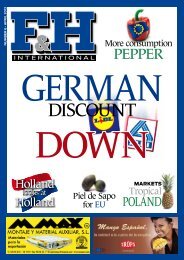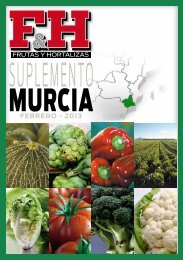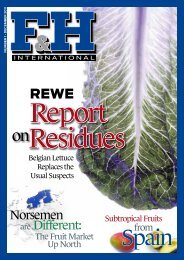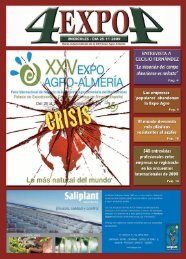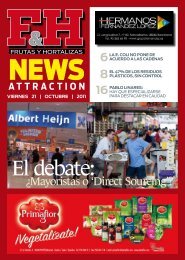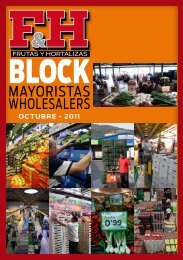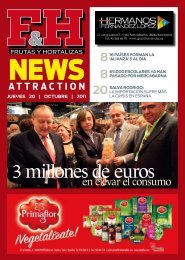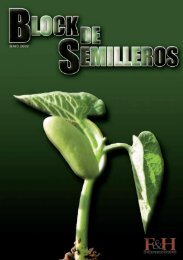09 leaf vegetables in spain
09 leaf vegetables in spain
09 leaf vegetables in spain
Create successful ePaper yourself
Turn your PDF publications into a flip-book with our unique Google optimized e-Paper software.
The apple production <strong>in</strong> the European Union this season is<br />
9.8 million tons, this figure means a decrease of 11%, if it is<br />
compared with the levels of harvest of the previous year. However<br />
if it is compared with the average of the last 3 years the volume<br />
decreases 7% accord<strong>in</strong>g to the last forecasts that the congress<br />
of Prognosfruit held <strong>in</strong> Kiev, capital of Ukra<strong>in</strong>e, <strong>in</strong> August.<br />
The supply of apples sent to the countries of the EU-15 will<br />
be 6.5 million tons, volume of 4.4 per cent which is less than<br />
the one of the previous year and 3 per cent below the average<br />
of the last three years.<br />
The decrease of the production <strong>in</strong> the EU-27 makes the<br />
exporters feel better. Example: Poland. This country is the ma<strong>in</strong><br />
apple producer of the East of Europe with an average supply<br />
I N F O C U S<br />
The EU apple yield decreases 11 per cent<br />
The apple production <strong>in</strong> the European Union <strong>in</strong> this campaign will decrease 11 per cent. The<br />
production of Poland, ma<strong>in</strong> European producer, will decrease 24 because of the bad climate<br />
conditions dur<strong>in</strong>g the flower<strong>in</strong>g and low yields. The production <strong>in</strong> the EU is 9, 8 million tons.<br />
about 2.4 million tons <strong>in</strong> a year, accord<strong>in</strong>g to the harvests of<br />
the last years. Nevertheless, this season, its supply of apples<br />
will decrease 24 per cent respect<strong>in</strong>g to the last year, which<br />
means a loss of volume of 620,000 tons.<br />
In fact, Alex Creisell, manager of Giropoma S.L anticipates<br />
that “the smaller apple availability for the next campaign helps<br />
to revalue a market much damaged by the press of the European<br />
retailers <strong>in</strong> a so globalized product like the apple is”.<br />
Another important data for the future of the <strong>in</strong>ternational<br />
trade of this fruit is the quality of the product. The supply of the<br />
West of Europe are apples of good quality whereas the one of<br />
the East have a lack of quality and size, so the f<strong>in</strong>al dest<strong>in</strong>ation<br />
of big part of these fruits go to the <strong>in</strong>dustry. n<br />
02
By Rafael I. Losilla<br />
In the last three years the cha<strong>in</strong>s of supermarkets of the<br />
United K<strong>in</strong>gdom have try to conv<strong>in</strong>ce to sell to mass media and<br />
the consumers their bet on the production “made <strong>in</strong> UK”. The<br />
flags of the UK were multiplied <strong>in</strong> the stands of fruits and<br />
<strong>vegetables</strong> of the stores and groups like Tesco, Asda or Waitrose<br />
signed plans of loyalty with English and Irish growers.<br />
However, the reality is another one and the presence of the<br />
British supply of fruits and <strong>vegetables</strong> <strong>in</strong> the English cha<strong>in</strong>s is<br />
at the present day much smaller than it was when the XXI<br />
century began. At the beg<strong>in</strong>n<strong>in</strong>g of the century the fruits and<br />
<strong>vegetables</strong> supply –<strong>in</strong>clud<strong>in</strong>g bulbs reached 43 per cent of the<br />
demand of the British market and at the end of 2008 it only<br />
reached 35 per cent; it means eight po<strong>in</strong>ts less.<br />
that criticized most this farce has been the “Irish Farmers<br />
Association”, who always have had differences with the Tesco<br />
cha<strong>in</strong>, that <strong>in</strong> Ireland is protected by the Keel<strong>in</strong>gs “category”.<br />
One year ago this association denounced that “the agreements<br />
of the Irish growers with the Tesco cha<strong>in</strong> put the survival of<br />
many producers at risk because of the very aggressive strategy<br />
of prices and without marg<strong>in</strong> for the bus<strong>in</strong>essmen”.<br />
The apple<br />
While the imports of <strong>vegetables</strong> <strong>in</strong>crease <strong>in</strong> the United<br />
K<strong>in</strong>gdom, some fruit send<strong>in</strong>gs have ga<strong>in</strong>ed the confidence<br />
T H E D A T A<br />
The British cha<strong>in</strong>s use the banner of the production<br />
<strong>in</strong> UK only like a lure strategy<br />
The English cha<strong>in</strong>s affirm to have <strong>in</strong>creased their operations and relations with the British<br />
producers of fruits and <strong>vegetables</strong>, but the reality is that the imports keep on rais<strong>in</strong>g and<br />
surpass<strong>in</strong>g 5.2 million tons. The cha<strong>in</strong>s opted for import due to a competitiveness question.<br />
The Data<br />
The import was 65 per cent of the consumption of fruits<br />
and <strong>vegetables</strong> <strong>in</strong> the United K<strong>in</strong>gdom dur<strong>in</strong>g 2008, eight<br />
po<strong>in</strong>ts more than at the beg<strong>in</strong>n<strong>in</strong>g of the XXI century. The<br />
British cha<strong>in</strong>s affirm to have improved their relations with<br />
the producers of fruits and <strong>vegetables</strong> <strong>in</strong> the United K<strong>in</strong>gdom,<br />
but the reality is that the imports <strong>in</strong>creased 29 per cent <strong>in</strong><br />
the period 2000-2008, whereas the <strong>in</strong>ternal commerce<br />
<strong>in</strong>creased more than 13 per cent.<br />
Tesco is the cha<strong>in</strong> that has had many problems with the British growers.<br />
of the English cha<strong>in</strong>s. It is the case of the apples. Dur<strong>in</strong>g the<br />
campaign 20<strong>09</strong> Sa<strong>in</strong>sbury´s was specially aggressive defend<strong>in</strong>g<br />
the English product, under the phrase “British and <strong>in</strong> season”.<br />
The English varieties Cox, Gala and Rubens were important<br />
<strong>in</strong> the stands of fruits and <strong>vegetables</strong>, until the po<strong>in</strong>t of which<br />
the association “English Apples & Pears” congratulated the<br />
cha<strong>in</strong>s Marks & Spencer, Waitrose and Asda on the effort of<br />
promot<strong>in</strong>g and send<strong>in</strong>g the British supply of apples to the<br />
customers.<br />
04<br />
Evolution consumption fruit&veg <strong>in</strong> UK<br />
(Millions tons). Source: Defra.<br />
n
LEAF VEGETABLES IN SPAIN<br />
Commerce of <strong>leaf</strong>. Spa<strong>in</strong> is <strong>in</strong> its place<br />
Spa<strong>in</strong> is today the third <strong>leaf</strong> world-wide product producer and the first <strong>in</strong>ternational supplier to<br />
the EU with 468,000 tons. The alternative to the Spanish supply from November to May comes<br />
from Italy and North Africa, ma<strong>in</strong>ly Tunisia that comes by the way of France and Italy.<br />
The Spanish supply of lettuce is sent to the whole Europe<br />
and it has an important situation <strong>in</strong> the <strong>in</strong>ternational trade <strong>in</strong><br />
spite of the decrease of the exports of 18 per cent <strong>in</strong> 20<strong>09</strong>.<br />
Spa<strong>in</strong> monopolizes 50 per cent of the send<strong>in</strong>gs or <strong>in</strong>ternational<br />
operations of lettuce <strong>in</strong> the European Union with its 467,000<br />
tons and is the reference of the demand <strong>in</strong> dest<strong>in</strong>ations like<br />
Poland, Austria or Germany.<br />
Spa<strong>in</strong> keeps on be<strong>in</strong>g a reference place from November to<br />
May, co<strong>in</strong>cid<strong>in</strong>g <strong>in</strong> the months of October and May with the<br />
productions of the North of Europe –France, United K<strong>in</strong>gdom,<br />
Germany, Poland and the Czech Rep. and hav<strong>in</strong>g like alternatives<br />
<strong>in</strong> the months from November to April the productions of Italy<br />
and the countries of North Africa, ma<strong>in</strong>ly Tunisia, that sends to<br />
the market of the EU more than 4,300 tons through Italy and<br />
France.<br />
Tunisia is not the only non<br />
communitarian supplier to the<br />
EU, although it is the fastest<br />
contribut<strong>in</strong>g nearly 3 per cent of<br />
the imports of lettuce to France.<br />
Egypt with 2,300 tons <strong>in</strong> 20<strong>09</strong><br />
and Morocco with 1,266 tons<br />
have jo<strong>in</strong>ed to the operations<br />
with European operators. Egypt<br />
enters through Italy, while<br />
Morocco does it through France<br />
and Spa<strong>in</strong>.<br />
Holland<br />
At the present day Holland is the second reference supplier<br />
of <strong>leaf</strong> products <strong>in</strong> the European market with its 95,000 tons<br />
exported –local production and re-export and with an own<br />
production nearly 85,000 tons focused on the months of summer.<br />
France, Germany, United K<strong>in</strong>gdom or Portugal are also<br />
countries of volume of production of lettuce like Holland is, to<br />
satisfy the needs of the European markets from May to October.<br />
The volume of the production of France is nearly 145,000 tons<br />
becom<strong>in</strong>g <strong>in</strong>to the eighth world-wide producer and Germany<br />
with 110,000 tons is the n<strong>in</strong>th world-wide producer.<br />
Share of market<br />
Spa<strong>in</strong> is the third world-wide producer of <strong>leaf</strong> products–<br />
Top Ten' <strong>in</strong>ternational suppliers of lettuce to EU (20<strong>09</strong>)<br />
05<br />
(Tns). Source: Eurostat.
LEAF VEGETABLES IN SPAIN<br />
Ch<strong>in</strong>a and the USA are on the top and this make to have a<br />
big and varied productive volume, which allows it to reach<br />
important shares of market <strong>in</strong> some dest<strong>in</strong>ations.<br />
is at the present time the first European importer of lettuce<br />
with a volume nearly 265,000 tons and is the first <strong>in</strong>ternational<br />
customer of Spa<strong>in</strong> –more than 181,000 tons-.<br />
Another market that is close to the maturity for the Spanish<br />
supply of <strong>leaf</strong> is the Nordic one. The share of market of Spa<strong>in</strong><br />
like a supplier of Sweden has <strong>in</strong>creased from 77 per cent <strong>in</strong><br />
2006 to 84 per cent <strong>in</strong> 20<strong>09</strong>.<br />
East of Europe<br />
The Spanish operators of lettuce agree <strong>in</strong> focus<strong>in</strong>g on the<br />
dest<strong>in</strong>ations of the East of Europe like market of future growth.<br />
This is already a reality <strong>in</strong> Poland, Czech Republic and Russia,<br />
although “the consumption of these products is not so<br />
favourable <strong>in</strong> dest<strong>in</strong>ations with low w<strong>in</strong>ter temperatures”,<br />
Luis Ronda, manager of Gs Spa<strong>in</strong>, expla<strong>in</strong>s.<br />
However, the imports of lettuce have <strong>in</strong>creased <strong>in</strong> these<br />
countries and Poland already reaches 22,000 tons, while the<br />
Czech Republic and Hungary are nearly 10,000 tons. n<br />
Penetration spanish lettuce offer for markets (20<strong>09</strong>)<br />
06<br />
Source: F&H with <strong>in</strong>formation Fepex and Eurostat.
By Rafael I. Losilla<br />
LEAF VEGETABLES IN SPAIN<br />
The “Top Ten” Spanish companies of the production<br />
of fresh lettuce<br />
Primaflor leads the production of lettuce <strong>in</strong> Spa<strong>in</strong> reach<strong>in</strong>g 150 million units of iceberg variety<br />
dur<strong>in</strong>g the 12 months. It is followed by Gs España that <strong>in</strong>creases its volume 6 per cent, and the<br />
next is Agromediterránea l<strong>in</strong>ked to Mercadona which has already 125 million units.<br />
Murcia and Almería capitalize the commercial power of the<br />
lettuce <strong>in</strong> Spa<strong>in</strong> and with Primaflor as the leader company of<br />
the production and commerce of lettuce reach<strong>in</strong>g 150 million<br />
of iceberg variety of fresh lettuce. These volumes, jo<strong>in</strong>ed to the<br />
other ones for process<strong>in</strong>g cause that this company controls “10<br />
per cent of the Spanish production of <strong>leaf</strong>”, Emilio Mur, general<br />
manager of the company, expla<strong>in</strong>s.<br />
The volume of production of fresh lettuce of the company<br />
is stable and the “fresh-cut” sector is <strong>in</strong>creas<strong>in</strong>g, and at the<br />
moment it is 27 per cent of the volume of bus<strong>in</strong>ess which is<br />
105 million euros. “We are work<strong>in</strong>g to be present <strong>in</strong> most of the<br />
Spanish and Portuguese cha<strong>in</strong>s”, Jordi Estrada, associate to<br />
the commercial manager of Iberia, affirms.<br />
The ma<strong>in</strong> advantage of the commercial-producers of lettuce<br />
<strong>in</strong> the Spanish Southeast is the control of the production <strong>in</strong> the<br />
surround<strong>in</strong>gs of 150 kilometres, with the capacity to produce<br />
dur<strong>in</strong>g the 365 days of the year.<br />
It is the case of Gs España, although the production of this<br />
company stops <strong>in</strong> the summertime mov<strong>in</strong>g its <strong>in</strong>terests to the<br />
fields that has <strong>in</strong> the Czech Republic as <strong>in</strong> the United K<strong>in</strong>gdom.<br />
The company has 12,000 hectares of surface, of which 4,000<br />
are <strong>in</strong> Spanish –Southeast of Spa<strong>in</strong> -.<br />
Spa<strong>in</strong><br />
07<br />
The Spanish market not only <strong>in</strong>creases the volume of Gs
España, but also directly the Agromediterránea one. This is the<br />
company that has <strong>in</strong>creased most its volume <strong>in</strong> the last two<br />
years. This <strong>in</strong>ter-supplier of Mercadona already produces 125<br />
million units, thanks to 55 million Roman lettuce and to 45<br />
million of little-gem, and they expect to <strong>in</strong>crease the volumes<br />
about 5 per cent for the campaign 2010-2011.<br />
Export<br />
LEAF VEGETABLES IN SPAIN<br />
Spa<strong>in</strong> becomes a place of possibilities for some companies,<br />
and the export is the most important part of the bus<strong>in</strong>ess of<br />
other group of companies. They are the case of Fruca Market<strong>in</strong>g,<br />
Natural Salads or Agrasa, among others.<br />
The important export of Fruca Market<strong>in</strong>g is between Germany<br />
and United K<strong>in</strong>gdom with its 115 million units of which 80 million<br />
are iceberg variety for fresh and 20 million for “fresh -cut”.<br />
The ”fresh-cut” is one of the options for some companies<br />
although the tendency is to decrease and ma<strong>in</strong>ly “after the<br />
complex situation of the United K<strong>in</strong>gdom and the value of the<br />
pound”, José Cánovas, manager of Fruca Market<strong>in</strong>g, affirms.<br />
“Nowadays the iceberg variety is be<strong>in</strong>g more important <strong>in</strong><br />
Germany and is start<strong>in</strong>g the <strong>in</strong>troduction <strong>in</strong> Poland and Russia”,<br />
Cánovas says.<br />
Germany has become one of the markets as much of volume<br />
as strategic of the Spanish producers, until the po<strong>in</strong>t of which<br />
“without Germany the English market could not be worked”,<br />
Cánovas asserts. n<br />
08
The programs of lettuce for the<br />
campaign of autumn-w<strong>in</strong>ter 2010-<br />
2011 will not undergo great changes<br />
respect<strong>in</strong>g to the previous one. This<br />
is what Proexport anticipates with<br />
Jose Cánovas like president of the<br />
organization.<br />
Murcia closed the last campaign<br />
with a surface of approximately<br />
9,300 hectares, an <strong>in</strong>crease of 1.6<br />
per cent, but without <strong>in</strong>fluence on<br />
the production due to the climate<br />
conditions of w<strong>in</strong>ter and spr<strong>in</strong>g. As<br />
well, Almeria reaches 6,800 hectares<br />
of <strong>leaf</strong> production, consolidat<strong>in</strong>g its<br />
position.<br />
LEAF VEGETABLES IN SPAIN<br />
The surface of lettuce of Spa<strong>in</strong> is stabilized<br />
The volume of supply and the surface of lettuce <strong>in</strong> Spa<strong>in</strong> for the autumn-w<strong>in</strong>ter plans will not<br />
change. This is what Proexport anticipates. The employer's organization of the Spanish lettuce<br />
has a good future <strong>in</strong> Germany and medium-term <strong>in</strong> the East of Europe.<br />
In fact, the first half of the year<br />
2010 closed with an <strong>in</strong>crease of 21<br />
per cent of the value of the exports of lettuce -369 million euros<br />
and a decrease of volume of 7% -363,000 tons -.<br />
This stable situation responds to the present demand and<br />
consumption, where no of the European cha<strong>in</strong>s nor dest<strong>in</strong>ations<br />
have <strong>in</strong>creased their demand <strong>in</strong> the w<strong>in</strong>ter plans.<br />
However, the future for Proexport looks good <strong>in</strong> medium-<br />
term, s<strong>in</strong>ce “Germany is bett<strong>in</strong>g on iceberg lettuce, because the<br />
German consumer values much the better use and <strong>in</strong> the last<br />
campaign the demand <strong>in</strong> the Germanic market was bigger and<br />
The lettuce for fresh consumption returns to the place <strong>in</strong> the plans of<br />
the cha<strong>in</strong>s dur<strong>in</strong>g this autumn-w<strong>in</strong>ter.<br />
with an <strong>in</strong>terest<strong>in</strong>g price”, Cánovas affirms.<br />
Proexport comments about the possibilities <strong>in</strong> the East of<br />
Europe –Poland, Czech Republic and Russia -, but these positive<br />
view will not result <strong>in</strong> an <strong>in</strong>crease of the supply of volume this<br />
year.<br />
<strong>09</strong><br />
n
M A R K E T S R E S E A R C H<br />
The courgette is out of the British crisis<br />
The demand of courgette <strong>in</strong> the United K<strong>in</strong>gdom is out of the crisis with a consumption over 3<br />
kilos. London is the centre of consumption of this product with the population 50-64 years old<br />
like its ma<strong>in</strong> demand.<br />
The consumption of courgette <strong>in</strong> the United K<strong>in</strong>gdom is liv<strong>in</strong>g<br />
a phase of stability <strong>in</strong>side the economic crisis. At the present<br />
day each Briton consumes 3.1 kilograms of courgette,“marrow”<br />
and auberg<strong>in</strong>e, of which “approximately 65 per cent is courgette”,<br />
accord<strong>in</strong>g to the research of the consumption“consult<strong>in</strong>g” of<br />
the sector.<br />
The figures of the consumption of these products <strong>in</strong>creased<br />
3 per cent dur<strong>in</strong>g the period 2007-2008 and each consumer<br />
spent almost 8 pounds on this family of products, of which 5.5<br />
pounds were for the purchase of courgettes.<br />
The figures of the demand of courgette has <strong>in</strong>creased s<strong>in</strong>ce<br />
2004 but also the value of the purchase. In 2004 the British<br />
spent more than 6.2 pounds buy<strong>in</strong>g courgettes and auberg<strong>in</strong>es<br />
and at the moment these expenses have <strong>in</strong>creased nearly 20<br />
per cent.<br />
At the present day, the courgette is on the second order <strong>in</strong><br />
the stand with 3-4 references <strong>in</strong> the British campaign and 1-2<br />
references <strong>in</strong> the import campaign, and also organic reference<br />
that is sold <strong>in</strong> packs of 3 units.<br />
In the last campaign, the British market imported more than<br />
34,000 tons, 13 per cent more than <strong>in</strong> 2007, after a specially<br />
complicated year due to the climate conditions <strong>in</strong> the South of<br />
Europe. The imports are <strong>in</strong> a stable phase with 35,000 tons and<br />
with Spa<strong>in</strong> like the first supplier.<br />
Spa<strong>in</strong> contributes to the United K<strong>in</strong>gdom with almost 60 per<br />
cent of the imports of courgette, but conditioned by the climate<br />
conditions of Spa<strong>in</strong> dur<strong>in</strong>g w<strong>in</strong>ter, although <strong>in</strong> the 2 last two<br />
years the presence of France has <strong>in</strong>creased 5 po<strong>in</strong>ts with<br />
products of Morocco, through the Perpignan way.<br />
London is the most important po<strong>in</strong>t of the consumption of<br />
courgette and auberg<strong>in</strong>e <strong>in</strong> the United K<strong>in</strong>gdom with a demand<br />
of 4.7 kilos per capita and <strong>in</strong>creas<strong>in</strong>g thanks to the citizens of<br />
white race, accord<strong>in</strong>g to the <strong>in</strong>formation of the British Service<br />
of Statistic.<br />
The consumption of courgette-auberg<strong>in</strong>e <strong>in</strong> the area of the<br />
South East is follow<strong>in</strong>g London with 4.2 kilos per capita as a<br />
result of the proximity of the British capital. In fact, the demand<br />
of courgette <strong>in</strong> the United K<strong>in</strong>gdom is smaller as the population<br />
is far away from London capital and thus the Scottish only<br />
consume 2.5 kilos and <strong>in</strong> the north of Ireland 1.7 kilos of<br />
courgette and auberg<strong>in</strong>e. n<br />
10<br />
Consumption courgette/auberg<strong>in</strong>e <strong>in</strong> UK (20<strong>09</strong>)<br />
(kgs. per cápita).<br />
Source: Defra/Kantar Worldpanel.
The <strong>in</strong>ternational bus<strong>in</strong>ess of the Spanish avocado<br />
The European market of avocado is gett<strong>in</strong>g back to Spa<strong>in</strong> thanks to the phenomenon to import<br />
this product from the South Hemisphere. The Spanish companies can keep the supply dur<strong>in</strong>g<br />
the 12 months. More than 50,000 tons of the Spanish avocado are sent to the UE.<br />
By Daniel Lafuente Torregrosa<br />
The <strong>in</strong>ternational figures of the Spanish avocado return aga<strong>in</strong><br />
thanks to the important support of the import of the South<br />
Hemisphere. This product, of noticeable <strong>in</strong>ternational<br />
characteristics, only had a consumption higher than 21,000<br />
tons distributed <strong>in</strong> the Spanish market <strong>in</strong> the campaign 2008-<br />
20<strong>09</strong>. This figure means 27 per cent of the Spanish production.<br />
The Spanish production dur<strong>in</strong>g the year 20<strong>09</strong> surpassed the<br />
80,000 tons and the imports volume was 42,500 tons and<br />
<strong>in</strong>creas<strong>in</strong>g.<br />
The bet of the Spanish companies on work<strong>in</strong>g imported<br />
products from – Peru, Chile or South Africa is mak<strong>in</strong>g easy partly<br />
the recovery of the supply com<strong>in</strong>g from Spa<strong>in</strong> <strong>in</strong> the <strong>in</strong>ternational<br />
markets.<br />
In fact, it is not necessary to forget that Spa<strong>in</strong> closed the<br />
year 20<strong>09</strong> with exports of more than 50,000 tons, with<br />
outstand<strong>in</strong>g shares of market <strong>in</strong> dest<strong>in</strong>ations like Germany,<br />
Denmark, Sweden, France and United K<strong>in</strong>gdom, among other<br />
markets.<br />
The supply of avocado of the tropical Coast is the response<br />
The phenomenon of the exports of the Spanish mango<br />
is becom<strong>in</strong>g more and more important thanks to its quality<br />
and recognition <strong>in</strong> the markets of all Europe.<br />
Spa<strong>in</strong> exported 8,552 tons <strong>in</strong> the last exercise be<strong>in</strong>g<br />
Portugal the most important dest<strong>in</strong>ation with more than 3,700<br />
tons. It is followed by France (1,586 tons) and Germany<br />
(1,466 tons).<br />
The mango will be no longer the great stranger of the<br />
subtropical fruits and the Spanish operators are <strong>in</strong>terested<br />
<strong>in</strong> supply<strong>in</strong>g it <strong>in</strong> the <strong>in</strong>ternational market, ma<strong>in</strong>ly, by reasons<br />
of price, although by comfort the national market is the most<br />
suitable.<br />
Another important fact to mention is that the imports<br />
which come from the South Hemisphere, Brazil, have the<br />
problem of the time that takes <strong>in</strong> arriv<strong>in</strong>g at the Old Cont<strong>in</strong>ent.<br />
M A R K E T S<br />
to the <strong>in</strong>ternational demands, s<strong>in</strong>ce 75 per cent of the exports<br />
are the Hass variety.<br />
France keeps on be<strong>in</strong>g one of the reference markets for the<br />
Spanish avocado, with exports that surpass 21,000 tons <strong>in</strong><br />
20<strong>09</strong>, although ,the orders decreased 2285 tons respect<strong>in</strong>g to<br />
the year 2008. concretely 9.8 per cent.<br />
Beh<strong>in</strong>d France, the Spanish avocado f<strong>in</strong>ds an ally <strong>in</strong> the<br />
British place, with send<strong>in</strong>gs that surpass the threshold of 5,000<br />
tons. Nevertheless, this figure means a decrease of the operations<br />
of 29 per cent, if it is compared with the data of the campaign<br />
2008.<br />
These two strategic places are the unique ones that surpass<br />
the threshold of 5,000 tons of avocado exported by the Spanish<br />
operators.<br />
Holland is on the third place, with 4,700 tons of avocado<br />
which is a customer needed by the Spanish operators due to<br />
the multiple possibilities of the re-export. Nevertheless, 20<strong>09</strong><br />
were not a good year and the figures of avocado decreased 17<br />
per cent. The Germanic market is very close to this last<br />
dest<strong>in</strong>ation, receiv<strong>in</strong>g nearly 4,000 tons, 24 per cent less than<br />
the other country mentioned before. n<br />
Portugal is the ma<strong>in</strong> dest<strong>in</strong>ation of the Spanish mango<br />
This is one of the reasons why the Spanish produc<strong>in</strong>gcommercial<br />
companies try to work with the <strong>in</strong>ternational<br />
market. “The characteristics of the Spanish mango are<br />
different from the competition, ma<strong>in</strong>ly by the dry climate <strong>in</strong><br />
our zone. Nevertheless, mango would be diversified, because<br />
at the present time 80 per cent is the Osteen variety “, Antonio<br />
Sanchez, manager of Frutas El Romeral, expla<strong>in</strong>s.<br />
12
M A R K E T S<br />
Trops leads the Spanish mango commerce<br />
Spa<strong>in</strong> is the important market for the own mango production by proximity and comfort, although<br />
the export is <strong>in</strong>creas<strong>in</strong>g and some tons are already sent to the EU dest<strong>in</strong>ation.<br />
The growth and commerce of the mango<br />
have been the latest subtropical product<br />
developed with noticeable volumes <strong>in</strong> Spa<strong>in</strong><br />
and the figures of the production already<br />
surpass 13,000 tons with a tendency to<br />
<strong>in</strong>crease.<br />
The prov<strong>in</strong>ce of Málaga has the crop and<br />
the commerce most professionalized, with<br />
a surface of approximately 3,500 hectares,<br />
although the Canary Islands had <strong>in</strong> 20<strong>09</strong> a<br />
production of 7,500 tons <strong>in</strong>to the hands of<br />
several operators.<br />
same <strong>in</strong> Málaga where the supply is more<br />
concentrated and only the Trops company<br />
commercializes 4,000 tons of this product, although little by<br />
little there are other companies with important figures. It is the<br />
case of Frutas El Romeral with a supply of 500 tons, distributed<br />
fifty fifty between the Spanish market and the export.<br />
And it is that the problem of the imports that come from the<br />
South Hemisphere, Brazil, is the time that takes <strong>in</strong> arriv<strong>in</strong>g at<br />
the Old Cont<strong>in</strong>ent. This is one of the reasons that the Spanish<br />
commercial-produc<strong>in</strong>g companies try to work with the<br />
<strong>in</strong>ternational market. “The Spanish mango has special<br />
characteristics that makes of it to be different from the<br />
competition, ma<strong>in</strong>ly, by the dry climate <strong>in</strong> our zone. Nevertheless,<br />
the varieties of mango have to be diversified because at the<br />
present time 80 per cent is the Ostim variety”, Antonio Sánchez,<br />
manager of Frutas El Romeral, expla<strong>in</strong>. n<br />
13<br />
Enrique Colilles.
PRODUCTION-DISTRIBUTION<br />
The French cha<strong>in</strong>s made the prices of the fruits and<br />
<strong>vegetables</strong> dropped dur<strong>in</strong>g 20<strong>09</strong><br />
The economic crisis was the argument and marked the<br />
tendency of the prices of fruits and <strong>vegetables</strong> on the part of<br />
the cha<strong>in</strong>s of big supermarkets and supermarkets <strong>in</strong> France.<br />
The retailers decreased the sale price to the customers more<br />
than 3 per cent for <strong>vegetables</strong> and 6 per cent for fruits.<br />
Dur<strong>in</strong>g 2008, the price average public sale of the fruits and<br />
<strong>vegetables</strong> <strong>in</strong> the French retailers reached 1.98 euros, and a<br />
year later was located <strong>in</strong> 1.88 euros. The French retailers has<br />
a share of market of fruits and <strong>vegetables</strong> of 71 per cent <strong>in</strong><br />
value and less than 70 per cent <strong>in</strong> volume.<br />
Chile is prepar<strong>in</strong>g the region of Maule to <strong>in</strong>crease<br />
cherry trees and berries<br />
The Region of Maule, <strong>in</strong> the centre of Chile, has 21 per<br />
cent of the fruit produced <strong>in</strong> this country so the Chilean<br />
government has the <strong>in</strong>tention to <strong>in</strong>crease the surface of<br />
cherry trees and berries <strong>in</strong> this zone.<br />
A report made by the Quality Control consultant and<br />
which magaz<strong>in</strong>e F&H has had access shows that the region<br />
of Maule has important advantages for grow<strong>in</strong>g these crops:<br />
“good soil and climate, water availability, <strong>in</strong>frastructure of<br />
The war of prices was more visible among the French<br />
supermarkets –Leclerc, Carrefour and Auchan- s<strong>in</strong>ce the average<br />
prices <strong>in</strong> one year period decreased almost 5 per cent <strong>in</strong><br />
<strong>vegetables</strong> and 9 per cent <strong>in</strong> fruits, tak<strong>in</strong>g advantage of the<br />
excess of stone fruit <strong>in</strong> summer 20<strong>09</strong>.<br />
Evolution prices fruit&veg french retailers<br />
Euro/Kgs. Source: Kantar Worldpanel.<br />
This important decrease of the prices <strong>in</strong> the French<br />
supermarkets caused an <strong>in</strong>crease of 5 per cent of the amounts<br />
sold, reason why the supermarkets closed 20<strong>09</strong> with a share<br />
of market of 33 per cent, the best <strong>in</strong> the last years, <strong>in</strong> spite of<br />
the tendency of this type of commerce to lose customers. n<br />
irrigation and capacity of process<strong>in</strong>g and storage of fruits”.<br />
The report “Research of the Intelligence of Bus<strong>in</strong>esses<br />
to support new fruit <strong>in</strong>vestments <strong>in</strong> Maulé” shows that the<br />
most suitable varieties of cherry tree <strong>in</strong> the region are late<br />
varieties like Kordia, the Reg<strong>in</strong>a and Sweetheart, but need<strong>in</strong>g<br />
“high density plantations and great level of automation to<br />
export to markets of the Far East”, the consultant expla<strong>in</strong>s.<br />
14<br />
n
Modelo is <strong>in</strong>troduc<strong>in</strong>g <strong>in</strong>to the organic<br />
The Model supermarkets which belong to Sonae group<br />
have started work<strong>in</strong>g with organic fruits and <strong>vegetables</strong><br />
with a dangerous bet on <strong>in</strong>creas<strong>in</strong>g their products <strong>in</strong> this<br />
ORGANIC LINE<br />
The decrease of the consumption of “organic”<br />
pear <strong>in</strong> the United K<strong>in</strong>gdom stops<br />
The bus<strong>in</strong>ess of the organic pear <strong>in</strong> the United K<strong>in</strong>gdom has<br />
kept stable <strong>in</strong> 3.7 million pounds after three years of cont<strong>in</strong>ued<br />
decreases s<strong>in</strong>ce <strong>in</strong> 2006 it almost reached 5 million pounds.<br />
This “stop” of the decrease has allowed it to ga<strong>in</strong> share of<br />
market <strong>in</strong> the organic fruits and <strong>vegetables</strong> bus<strong>in</strong>ess, s<strong>in</strong>ce<br />
except the case of citruses and pear, the sales of other crops<br />
decreased.<br />
At the present day the sales of pear are 1.7 per cent of the<br />
organic sales opposite to 1.5 per cent <strong>in</strong> 2008. One of the<br />
Evolution consumption of organic pear <strong>in</strong> UK<br />
reasons to stop this decrease has been the promotions that the<br />
producers and operators have made to keep the sales. Thus <strong>in</strong><br />
In million pounds.<br />
2008 the British consumers paid 2.70 pounds by kilo of organic pear opposite to 2.57 pounds <strong>in</strong> 20<strong>09</strong>. n<br />
In the stands of Modelo there are more than 30 products.<br />
sector. The Modelo supermarket has 30 organic products<br />
from Portuguese suppliers dur<strong>in</strong>g this summer.<br />
Vegetables have been the stars count<strong>in</strong>g on <strong>leaf</strong> product<br />
range, tomatoes, peppers, cucumbers, courgettes or<br />
endives, without los<strong>in</strong>g their philosophy to supply “the<br />
best product to the best price”, from Model.<br />
The reference of organic <strong>vegetables</strong> <strong>in</strong> Model has<br />
been supply <strong>in</strong> cold with the <strong>in</strong>tention of a better<br />
conservation and visible way <strong>in</strong> the corner of the<br />
stands. Sonae as well as Intermarché are the groups<br />
located <strong>in</strong> Portugal that have bet on the organic range<br />
of <strong>vegetables</strong>.<br />
15<br />
n
COMPANIES<br />
The Spanish companies control the Spanish bean<br />
The hectares of greenhouses of bean <strong>in</strong> Morocco are 3,000 and the Spanish companies<br />
control direct or <strong>in</strong>direct way 60 per cent of the production and surface and 55 per cent<br />
of the foreign trade. The GPA company leads the surface of bean monopoliz<strong>in</strong>g<br />
10 per cent of the surface of this crop.<br />
By Rafael I. Losilla<br />
Morocco exported almost 113,000 tons of beans <strong>in</strong> the year<br />
20<strong>09</strong> of which almost 63,000 tons go to Spa<strong>in</strong>, do<strong>in</strong>g of this<br />
the most important dest<strong>in</strong>ation of the Moroccan producers.<br />
The importance of Spa<strong>in</strong> <strong>in</strong> Morocco at commercial level<br />
has <strong>in</strong>creased gradually and not only by commercial<br />
relations, but also by <strong>in</strong>vestments <strong>in</strong> production.<br />
ago the first Spanish <strong>in</strong>vestors arrived at Morocco with<br />
the <strong>in</strong>tention to develop platforms and productive fields<br />
of beans, based on the high yield of the crop and an<br />
approachable labour. 15 years later, the Spanish companies<br />
control between 55-60 per cent of the production and<br />
surface direct or <strong>in</strong>direct way and 55 per cent of the foreign<br />
trade.<br />
important companies like Azura, Idyl, Les Doma<strong>in</strong>es or<br />
Agafay have given up gradually this crop and this place<br />
has been taken of direct or <strong>in</strong>direct way by the Spanish<br />
companies.<br />
The companies<br />
Although the companies of the Hispanic-Moroccan<br />
capital become more and more important <strong>in</strong> the Moroccan<br />
surface, the GPA company leads the surface of bean <strong>in</strong> Morocco<br />
with 300 hectares, of which 200 belong to the company and<br />
100 to the partner producers.<br />
The control of the bean <strong>in</strong> Morocco is diversified and there<br />
are many producers and <strong>in</strong>dependent companies with surface<br />
of less than 50 hectares and many small producers that add<br />
less than 2 hectares and that work of free and spontaneous<br />
way, outside plans and commitments.<br />
This situation means 29 per cent of the 3,000 hectares of<br />
bean <strong>in</strong> Morocco, accord<strong>in</strong>g to the analysts of seeds consulted<br />
by F&H. The orig<strong>in</strong> of most of these small producers is Morocco.<br />
Spanish capital<br />
The Spanish companies are much organized and look at the<br />
Spanish market as much as at the French one. In fact, the<br />
platforms of Mercamadrid and Mercabarna have become<br />
important markets of the bean of Morocco. Mercabarna receives<br />
directly 12 per cent of the total Moroccan commercial bean and<br />
the case of Mercamadrid is that receives more than 60 per cent<br />
of its bean from North Africa. n<br />
17<br />
Bean percentaje surface <strong>in</strong> Morocco (2008)<br />
Source: F&H. (1) Estimate.
The Coprohníjar company will keep the same figure of<br />
hectares of cherry tomato <strong>in</strong> the campaign 2010-2011 accord<strong>in</strong>g<br />
to gathers its plan of production and it will decrease its surface<br />
of organic crop. It will strength its bet on the biological control,<br />
as well as the activity dur<strong>in</strong>g the 12 months.<br />
The company commercialized dur<strong>in</strong>g the last<br />
campaign 10,000 tons of loose cherry tomato<br />
and more than 3,600 tons of special varieties<br />
of cherry, as well as 1,200 tons of cocktail<br />
tomato.<br />
In addition to cherry, the company keeps<br />
its volumes of loose tomato and truss tomato.<br />
Coprohníjar f<strong>in</strong>ished the year with nearly 4,300<br />
tons of loose tomato and 2,500 tons of truss<br />
tomato. The company will keep on hav<strong>in</strong>g its<br />
bet on the <strong>in</strong>novation of tomatoes and for this<br />
year it has 17,000 square meters of the Raf<br />
tomato Rebelión of the Vilmorín seeds. However,<br />
the company has decreased the surface of the<br />
Corazón de Buey tomato.<br />
Watermelon keeps on be<strong>in</strong>g the reference<br />
of the company for spr<strong>in</strong>g and dur<strong>in</strong>g the last<br />
COMPANIES<br />
Coprohníjar will keep its bet on cherry tomato<br />
campaign it reached a supply of 10,500 tons of l<strong>in</strong>ed watermelon<br />
and more than 5,000 tons of black one, <strong>in</strong> addition to 1,200<br />
tons of m<strong>in</strong>i-watermelon. France is the reference dest<strong>in</strong>ation of<br />
the watermelon of Coprohníjar. The company closed the campaign<br />
with a commercial volume of 42,100 tons. n<br />
LQA will supply directly their plans of courgette <strong>in</strong> the EU<br />
Jose Manuel Escobar is the manager of LQA.<br />
Tons. Source: Coprohnijar.<br />
The company of Almería LQA- Legalitas Quality<br />
Assurance- will supply this campaign of direct way its plans<br />
of courgette to the European cha<strong>in</strong>s, after break<strong>in</strong>g off the<br />
commercial relations with Lomanoryas due to disagreements<br />
with the partners <strong>in</strong> the management of this one. Last<br />
campaign LQA commercialized 6,000 tons.<br />
The aim of LQA is to reach the same volume of the last<br />
campaign, reason why it has created a field structure to<br />
extend its network of courgette suppliers and to work “from<br />
the field to the supermarket”, Escobar affirms.<br />
The company is look<strong>in</strong>g for a k<strong>in</strong>d of specific grower:<br />
“experienced and with knowledge <strong>in</strong> the handl<strong>in</strong>g of this<br />
product, s<strong>in</strong>ce our plans are much l<strong>in</strong>ked to English and<br />
German cha<strong>in</strong>s”, Jose Manuel Escobar, LQA manager,<br />
expla<strong>in</strong>s.<br />
“We also look for producers to keep the crop dur<strong>in</strong>g 10<br />
months from September to June to be able to reach the<br />
signed commitments without problems” Escobar affirms.n<br />
18<br />
Products of Coprohnijar (2010-2011)




